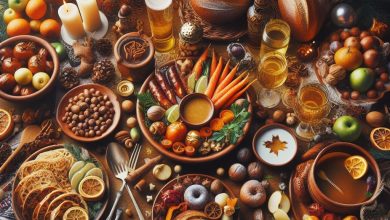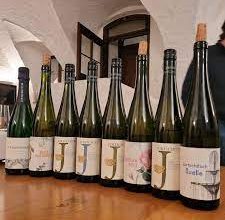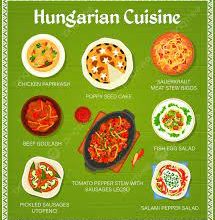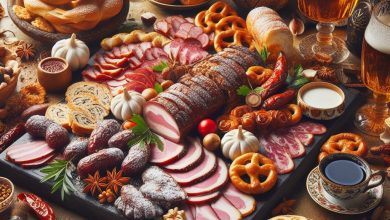National cuisine of Hungary
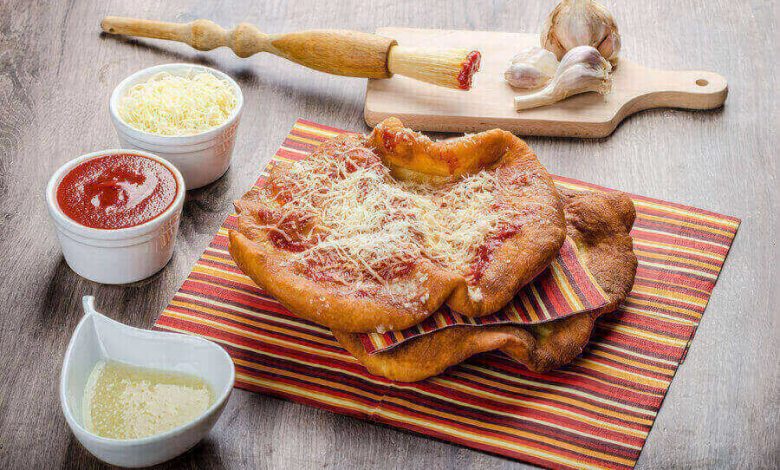
Hungary is one of the countries beloved by tourists in Central Europe. A country with a colorful national culture, traditions and cuisine. Tourists love Hungary for its unique attractions, delicious national cuisine, thermal springs, low prices and good service.
The fame of Hungarian chefs resounded throughout Europe. Hungarian kings honored their cooks and granted them nobility. In Hungary there is a village called Kirajsokacsy (translated as “royal cooks”). According to legend, many Holy Roman Emperors, in particular the famous Sigismund, invited cooks only from Kiraisokachi.
Most dishes use green bell peppers, tomatoes and the most popular seasoning – ground dried paprika. Another favorite ingredient of Hungarians is sour cream.
Hungarian soups.
Hungarians often consume soups. It can be a sweetish vegetable soup, hearty meat or the famous goulash.
One of the main dishes is Hungarian goulash, which is something between a meat stew and a soup. According to legend, goulash was invented by Hungarian shepherds. Translated from Hungarian, “goulash” means shepherd. Hungarians love goulash very much; they cook it always and everywhere.
Every year the town of Szolnok hosts the Goulash Festival, where chefs from all over the country compete in preparing this dish. For example, “Palócgulyás” is goulash with green beans, and “Alfold” is goulash with potatoes, carrots and parsnips.
Hungarians love river fish dishes. The most popular is the spicy fish soup – Halaszle, Hungarian fish soup (halasle). The Hungarians have a proverb: “Any fish will be tasty only in the third water. The first is river, the second is in a cauldron, and the third is the one with which they wash down the fish.” We are talking about the famous Tokaj wine.
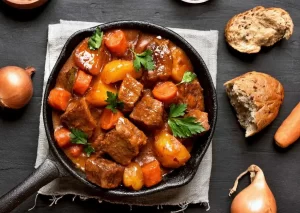
Hearty bean soups are popular in Hungary, especially Jókai – bean soup. And also chicken broth – “Újházy”.
Paprikash is prepared only from white meat – poultry, lamb, veal and fish. The peculiarity of this dish is that it must be seasoned with paprika and sour cream sauce.
They are prepared for Christmas and Easter.
Kereset is a traditional Hungarian dish, a special paste for spreading on bread. It consists of sheep cheese, lightly salted caviar, chopped sardines and anchovies, capers and many spices: grated onion, cumin, paprika, mustard. This whole mixture is ground with beer.
Another favorite dish of Hungarians is lecso. This is a traditional dish made from onions, paprika, tomatoes, lightly smoked pork sausage or paprikash chicken with dumplings.
Vegetables in Hungary are prepared in a special way. They are cut into small pieces, stewed in a small amount of water, then flour sautéing with sour cream or grated potatoes is added. Such dishes are called fazelok. Fezeleks made from zucchini, spinach, cabbage, potatoes, lentils, beans, and kohlrabi are especially popular in Hungary. Hungarians love boiled and stewed vegetables.
The most popular meat dishes are “Pörkölt” and “paprikás”.
Chicken paprikash is a favorite Hungarian dish. Paprikash is prepared only from white meat – poultry, lamb, veal and fish. The peculiarity of this dish is that it must be seasoned with paprika and sour cream sauce.
In Hungary they cook pasta dishes. This original dish is noodles with cottage cheese, sour cream and cracklings. There is also “Turos csusza” – pasta with cottage cheese and “káposztás tészta” – egg squares with stewed cabbage and spicy pastas.
Kereset is a traditional Hungarian dish, a special paste for spreading on bread. It consists of sheep cheese, lightly salted caviar, chopped sardines and anchovies, capers and many spices: grated onion, cumin, paprika, mustard. This whole mixture is ground with beer.
Another favorite dish of Hungarians is lecso. This is a traditional dish made from onions, paprika, tomatoes, lightly smoked pork sausage or paprikash chicken with dumplings.
Vegetables in Hungary are prepared in a special way. They are cut into small pieces, stewed in a small amount of water, then flour sautéing with sour cream or grated potatoes is added. Such dishes are called fazelok. Fezeleks made from zucchini, spinach, cabbage, potatoes, lentils, beans, and kohlrabi are especially popular in Hungary. Hungarians love boiled and stewed vegetables.

Hungarian pastries, cakes, snacks.
Among the sweet dishes, one can highlight retesh – Hungarian strudel. Buns – “Retes” – puff pastry with different fillings. The roots of Hungarian strudel come from the tradition of preparing Turkish baklava, which took root in Hungary during the time of Turkish rule. Hungarian strudel can be filled with apples, nuts, poppy seeds, cherries, as well as meat, fish, cabbage and mushrooms. To prepare Hungarian strudel, you need special flour with a high gluten content.
Hungarians also love to prepare rolls with various fillings, puff pastries and Hungarian nut pie.
There are many coffee shops and cafes in Hungary where you can try the following sweets:
“Dobos Torta” is a multi-layer cake with thick chocolate cream, covered with crispy caramel.
“Eszeteházy Torta” – multi-layer cake with nut cream.
“Krémes” is a light vanilla cream that is used between two layers of crispy layer cake.
“Rigó Jancsi” is a chocolate sponge cake filled with airy chocolate mousse and covered with chocolate.
“Rákóczi Turos” – cottage cheese cake.
Usually, at festivals and events they sell “Kürtős kalács” – a hollow cylindrical dough covered with powdered sugar, cinnamon or walnuts.
“Gesztenye pure” – chestnut puree or “Somali gadulka” – sponge cake made from flaky dumplings with chocolate sauce, rum and whipped cream are typical hearty Hungarian desserts.
For snacks, you can try fresh baked goods from the bakery, such as “Turos taška” – cookies filled with cottage cheese, or “Kakos Cigar” – “coconut snail” – a ball-shaped dough filled with chocolate. Hungary has its own unique fast food – lingo’s. “Lagos” – deep-fried round dough. This is a flatbread made from unleavened yeast dough, which is boiled in boiling oil. It is also used as a snack with lecho or as a dessert with chocolate spread and jam.

